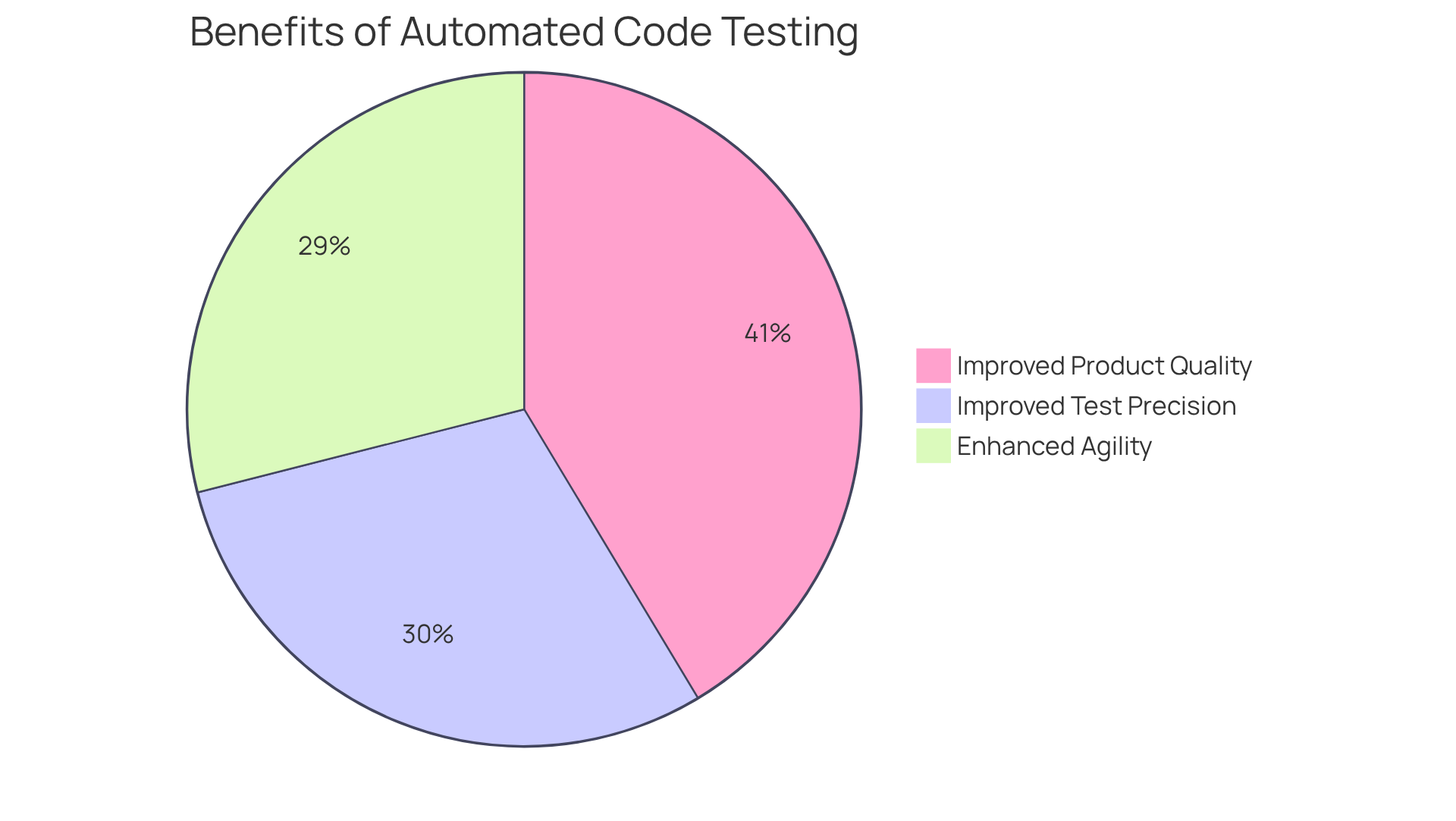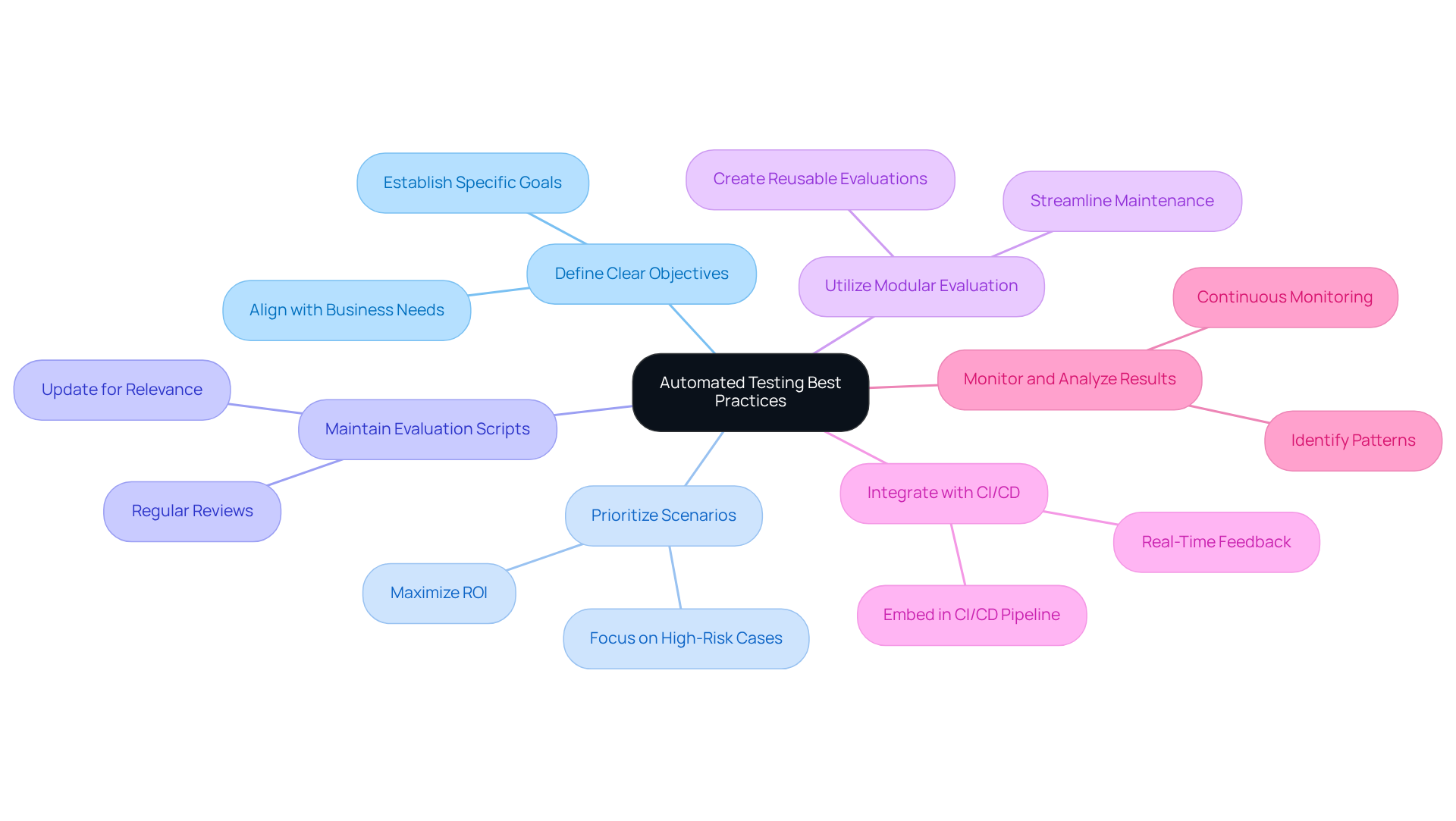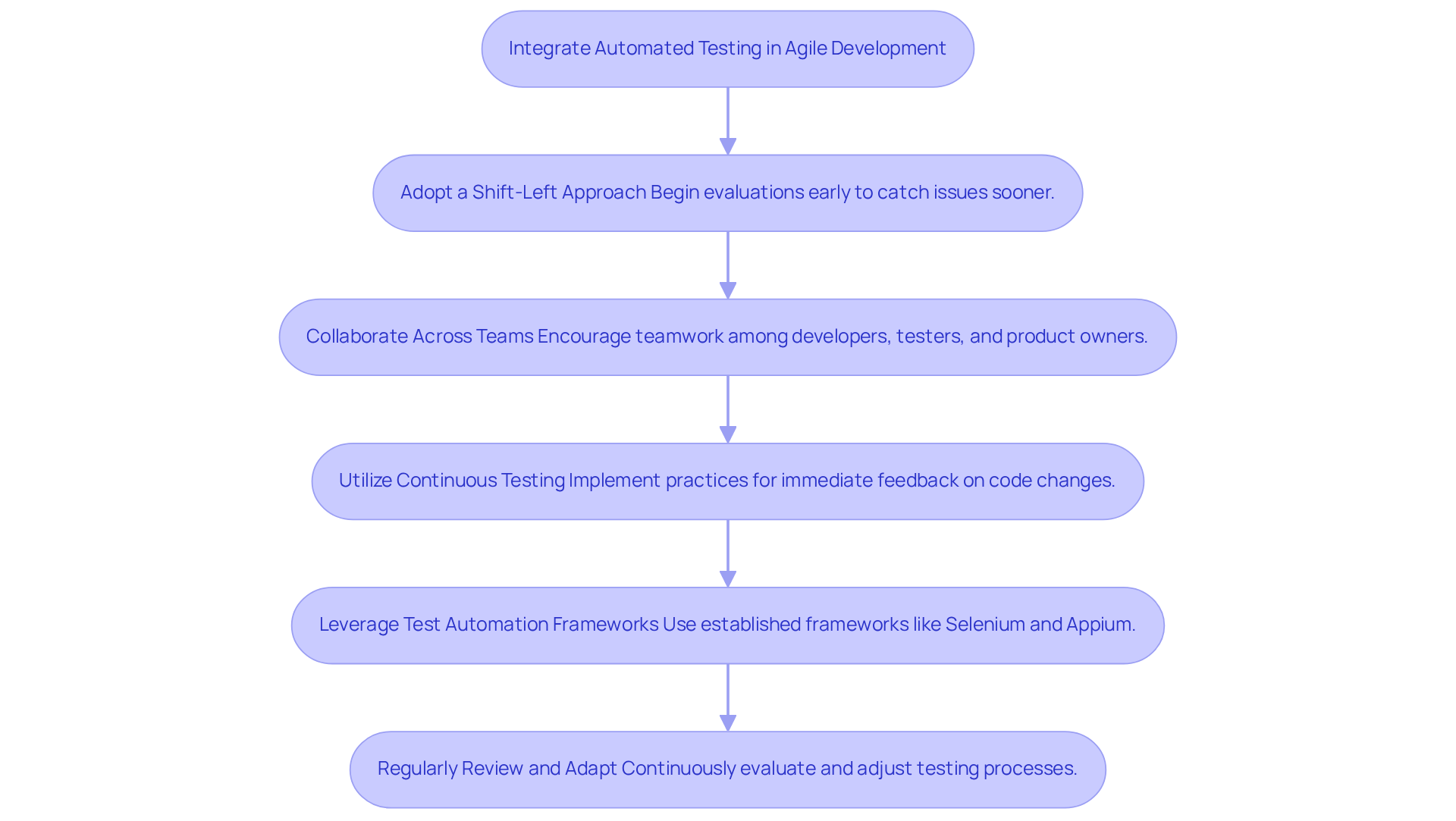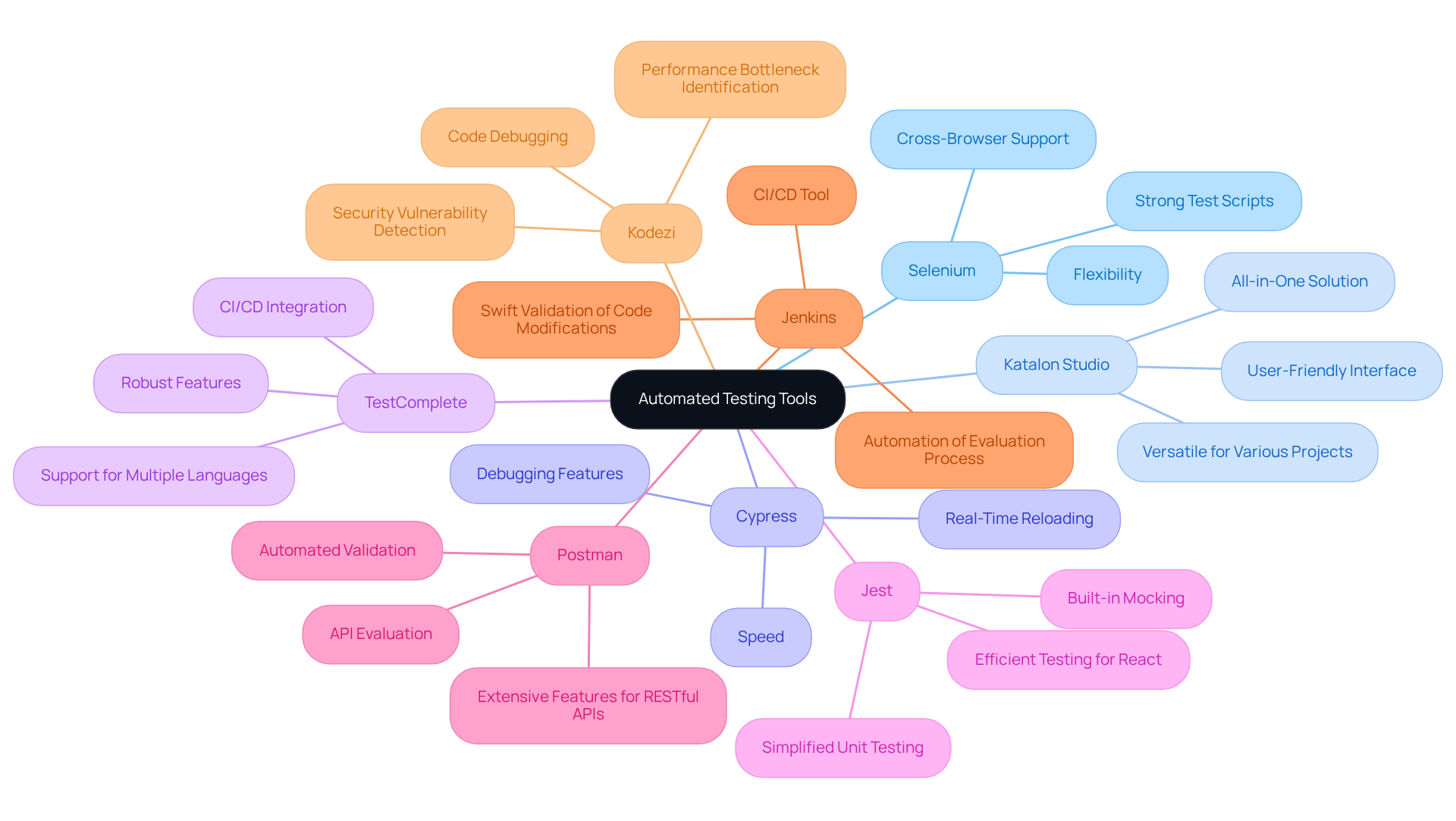Overview
Coding challenges can often hinder developers, impacting both efficiency and code quality. Automated code testing is essential for enhancing these aspects within Agile development frameworks. Kodezi addresses these challenges by implementing automated testing, which not only reduces defect rates and manual effort but also allows teams to focus on complex evaluations. Furthermore, this leads to faster release cycles and improved software quality.
Have you ever wondered how automated testing could transform your development process? By adopting Kodezi, teams can streamline their workflows and enhance productivity. The platform's features empower developers to tackle intricate coding tasks with confidence, ensuring that quality is never compromised. In addition, the reduced manual effort frees up valuable time, allowing teams to innovate and improve their products.
The benefits of using Kodezi are clear:
- Improved productivity
- Enhanced code quality
- A more efficient development cycle
Why not explore the tools available on the platform and see how they can elevate your coding practices? With Kodezi, you can take your development efforts to the next level, ensuring that your software not only meets but exceeds expectations.
Introduction
In the fast-paced world of software development, coding challenges can derail even the most agile teams. Automated code testing emerges as a crucial ally in this landscape. This practice not only enhances code quality but also streamlines the development process, enabling teams to focus on complex problem-solving rather than repetitive tasks.
As organizations strive for efficiency, a pressing question arises: how can teams effectively implement automated testing to keep pace with rapid changes and elevate the overall quality of their software?
Furthermore, Kodezi offers specific features that address these challenges head-on. By utilizing Kodezi, teams can significantly improve productivity and code quality, making it an invaluable tool in their development arsenal.
Explore the tools available on the platform to discover how you can transform your coding practices.
Understand Automated Code Testing and Its Importance
In the ever-evolving landscape of software development, coding challenges are a common hurdle that developers encounter. Automated code testing emerges as a vital solution, particularly within Agile frameworks. Tools like Kodezi CLI play a significant role in this process, performing evaluations on the codebase automatically to ensure that new changes do not introduce bugs or regressions. This not only enhances code quality but also allows teams to focus on more intricate evaluation scenarios.
Furthermore, Kodezi CLI independently identifies and resolves codebase issues promptly, boosting programming efficiency. The importance of automated code testing lies in its ability to provide quick feedback, improve test coverage, and reduce the manual effort associated with evaluations. By automating repetitive tasks, teams can redirect their efforts toward advanced evaluations, ultimately leading to higher quality software and faster release cycles.
As codebases grow in complexity, automated code testing becomes essential for maintaining code quality and meeting industry standards. Research indicates that organizations implementing mechanized evaluations experience a significant decrease in defect rates, with:
- 43% of companies reporting improved test precision
- 42% experiencing enhanced agility after automation
- 60% of participants citing improved product quality as a key reason for adopting automated code testing
Practical examples illustrate that systematic evaluations, especially with resources like Kodezi CLI, not only streamline processes but also enhance overall team efficiency. This makes automated code testing an essential practice for any development group that is striving for excellence. Are you ready to explore the capabilities of Kodezi CLI? A quick 5-minute demo is available to showcase its features and benefits.

Implement Best Practices for Effective Automated Testing
In the realm of software development, teams often encounter challenges with automated code testing. To effectively implement automated code testing, it is vital to adhere to several best practices that can significantly enhance software quality.
-
Define Clear Objectives: Establish specific goals for automated evaluations, such as reducing regression evaluation time or increasing overall coverage. This clarity helps align efforts with business needs and ensures that the testing process is purposeful.
-
Prioritize Scenarios: Concentrate on automating high-risk and frequently executed cases first. By addressing these critical areas, teams can maximize their return on investment (ROI) and significantly impact software quality.
-
Maintain Evaluation Scripts: Regularly review and update evaluation scripts to ensure they remain relevant and efficient as the codebase evolves. This practice not only prevents obsolescence but also enhances the reliability of testing efforts.
-
Utilize Modular Evaluation: Create evaluations to be modular and reusable. This approach streamlines maintenance and improves the reliability of assessments, allowing teams to adapt quickly to changes in the codebase.
-
Integrate with CI/CD: Ensure that automated evaluations are embedded within your Continuous Integration/Continuous Deployment (CI/CD) pipeline. This integration provides real-time feedback on code changes, facilitating quicker responses to issues and enhancing overall workflow.
-
Monitor and Analyze Results: Continuously monitor test results and analyze failures to identify patterns and areas for improvement. This ongoing examination fosters a culture of quality and drives enhancements in the evaluation process.
By adhering to these optimal methods, teams can establish a robust framework for automated code testing that supports agile development and significantly enhances software quality. Are you ready to elevate your automated testing practices?

Integrate Automated Testing in Agile Development for Enhanced Quality
Incorporating systematic evaluations into Agile development methodologies is crucial for improving software quality and guaranteeing prompt delivery. Developers often face significant coding challenges that can complicate the evaluation process. Agile methodologies highlight iterative development and regular releases, which can result in heightened complexity in evaluation. So, how can teams effectively integrate automated code testing into their processes?
-
Adopt a Shift-Left Approach: Begin evaluations early in the development process to identify and address issues before they escalate. This proactive strategy has been shown to enhance defect detection rates by up to 35% compared to traditional methods. Wouldn’t it be beneficial to catch issues sooner rather than later?
-
Collaborate Across Teams: Encourage teamwork among developers, testers, and product owners to ensure that evaluation aligns with business objectives and user requirements. Effective communication can significantly enhance the success of automated code testing initiatives, as 90% of businesses recognize its importance for digital transformation. How well are your teams collaborating?
-
Utilize Continuous Testing: Implement continuous testing practices to provide immediate feedback on code changes, allowing for quick adjustments and improvements. Kodezi’s AI improves code modifications from your developers as part of your software development lifecycle, ensuring that testers identify issues before they escalate, thus enhancing your code quality with each release. Imagine the efficiency gains this could bring!
-
Leverage Test Automation Frameworks: Utilize established test automation frameworks that support Agile practices, allowing groups to write and execute tests efficiently. Popular frameworks like Selenium and Appium are widely adopted, with 64.2% and 22% usage rates, respectively, among testers. Are you using the right tools for your testing needs?
-
Regularly Review and Adapt: Continuously evaluate the effectiveness of machine-assisted evaluations within the Agile framework and make necessary adjustments to enhance processes. This iterative review process is essential, as organizations that implement automation report a decrease in manual assessment efforts by over 40%, enabling groups to concentrate on more intricate tasks. How often do you assess your evaluation processes?
By incorporating automated code testing into Agile development, groups can enhance code quality, reduce time to market, and improve overall project results. Explore the tools available on Kodezi's platform to see how they can address your coding challenges and boost your productivity.

Leverage Tools and Technologies for Streamlined Automated Testing
To optimize mechanical evaluations, groups should utilize a range of instruments and technologies designed for their particular requirements. Key tools to consider include:
-
Selenium: A widely-used open-source tool for automating web applications across different browsers. It is preferred by 64.2% of respondents in the industry, making it the leading option for automation. Selenium's flexibility enables groups to develop strong test scripts that can be run across various platforms, improving test coverage and reliability.
-
Katalon Studio: An all-in-one automation solution that supports web, API, mobile, and desktop evaluations, making it versatile for various projects. Its user-friendly interface and comprehensive features enable teams to apply evaluation strategies efficiently.
-
Cypress: A contemporary framework created for end-to-end evaluation of web applications, recognized for its speed and simplicity. Cypress offers real-time reloading and debugging features, establishing it as a favored option among developers for evaluating dynamic web applications.
-
TestComplete: A commercial tool that provides robust features for automated evaluation of desktop, web, and mobile applications. Its support for various scripting languages and integration with CI/CD pipelines enhances its utility in diverse evaluation environments.
-
Jest: A JavaScript framework for evaluating React applications, offering a straightforward and efficient method to create tests. Jest's built-in mocking features simplify the evaluation process, enabling efficient unit and integration assessments.
-
Postman: A powerful tool for API evaluation that allows teams to automate and validate API responses efficiently. With its extensive features for evaluating RESTful APIs, Postman is essential for ensuring the reliability of backend services.
-
Jenkins: A widely used CI/CD tool that can be combined with self-operating evaluation frameworks to enable continuous assessment. Jenkins allows groups to automate the evaluation process, ensuring that code modifications are validated swiftly and effectively.
-
Kodezi: A groundbreaking tool that improves code debugging processes, enabling groups to quickly identify and resolve codebase problems, including performance bottlenecks and security vulnerabilities. Kodezi provides detailed explanations and insights into what went wrong and how it was resolved, ensuring that code adheres to the latest security best practices and coding standards. This ability not only improves performance but also boosts code quality, rendering it a vital component of any evaluation toolkit.
By choosing the appropriate tools and technologies, including Kodezi, teams can enhance their capabilities for automated code testing, improve collaboration, and ultimately deliver higher-quality software. The efficacy of these tools is highlighted by the fact that 75% of organizations think that automated code testing accelerates innovation, enabling more thorough and uniform evaluations. Furthermore, 60% of organizations utilizing automated code testing indicate considerable enhancements in application quality. However, 26% of teams face difficulties selecting the right test automation tools, highlighting the importance of careful evaluation and balancing automation with manual testing.

Conclusion
Automated code testing is essential in the world of software development, especially within Agile frameworks. Its importance is highlighted by its ability to enhance code quality, reduce manual evaluation efforts, and speed up release cycles. By utilizing tools like Kodezi CLI, teams can ensure their code remains robust and free from defects, allowing them to concentrate on delivering innovative solutions rather than becoming mired in repetitive tasks.
This article outlines key strategies for implementing effective automated testing. These include:
- Defining clear objectives
- Prioritizing high-risk scenarios
- Maintaining evaluation scripts
- Integrating automated testing within CI/CD pipelines
Such best practices not only streamline the testing process but also cultivate a culture of continuous improvement, ultimately leading to superior software quality and more efficient development cycles. Furthermore, collaborative efforts among teams amplify the overall effectiveness of automated testing, ensuring alignment with business goals.
In summary, adopting automated code testing is not just a trend; it is a necessary evolution for any development team striving for excellence. The advantages are evident: enhanced software quality, reduced defect rates, and increased agility. As the software development landscape continues to evolve, embracing these practices and leveraging the right tools will be vital for maintaining competitiveness. Teams are encouraged to explore the capabilities of advanced testing solutions and commit to ongoing improvement in their automated testing strategies to unlock their full potential.
Frequently Asked Questions
What is automated code testing?
Automated code testing is a process that uses tools to automatically evaluate a codebase to ensure that new changes do not introduce bugs or regressions, enhancing overall code quality.
Why is automated code testing important in software development?
It provides quick feedback, improves test coverage, reduces manual effort, and allows teams to focus on more complex evaluation scenarios, leading to higher quality software and faster release cycles.
How does Kodezi CLI contribute to automated code testing?
Kodezi CLI performs evaluations on the codebase automatically, identifies and resolves issues promptly, and boosts programming efficiency, making it a valuable tool for teams.
What benefits do organizations experience from implementing automated code testing?
Organizations report a decrease in defect rates, with 43% noting improved test precision, 42% experiencing enhanced agility, and 60% citing improved product quality.
How does automated code testing affect team efficiency?
By streamlining processes and automating repetitive tasks, automated code testing enhances overall team efficiency, allowing developers to focus on more advanced evaluations.
What is the impact of growing codebase complexity on testing practices?
As codebases grow in complexity, automated code testing becomes essential for maintaining code quality and meeting industry standards.
Is there a way to see Kodezi CLI in action?
Yes, a quick 5-minute demo is available to showcase the features and benefits of Kodezi CLI.




